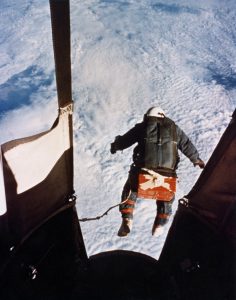How appropriate for this week! – 2 June 1957 At 6:23 a.m., Central Daylight Time (11:23 UTC), Captain Joseph W. Kittinger, Jr., United States Air Force, lifted off from Richard E. Fleming Field (SGS), South Saint Paul, Minnesota, in the gondola of a helium balloon designed and built by Winzen Research Inc.
 At age 28, in the early dawn, Joe boarded a small gondola under a high balloon. He was to test man’s endurance in space. Upward he went more than eighteen miles; it was the highest man had ever gone and he became known as “the first man in space”.
At age 28, in the early dawn, Joe boarded a small gondola under a high balloon. He was to test man’s endurance in space. Upward he went more than eighteen miles; it was the highest man had ever gone and he became known as “the first man in space”.
At 8:04 a.m. (13:04 UTC), Captain Kittinger reached a pressure altitude of 95,000 feet (28,956 meters). This was only 400 feet (122 meters) short of the balloon’s theoretical pressure ceiling. The flight was cut short due to one of the capsule’s valves being installed backward which vented the oxygen supply outside but not before reaching a record altitude of 96,784 feet.

Later in 1960, he rode another balloon to the height of 102,000 feet. Wearing a bulky pressure suit he climbed out of the balloon. He descended for four minutes 38 seconds, finally reached the speed of 614 MPH, even though there was a drag chute which was used to slow his descent When asked about his fall, he said, “I didn’t have time to worry ” This gave Colonel Kittinger the record for the highest jump and longest free fall. Later he was given the credit for testing the parachute which would be used by astronauts in the event that an ejection was necessary.
Of the jumps from Excelsior, Kittinger said:
There’s no way you can visualize the speed. There’s nothing you can see to see how fast you’re going. You have no depth perception. If you’re in a car driving down the road and you close your eyes, you have no idea what your speed is. It’s the same thing if you’re free-falling from space. There are no signposts. You know you are going very fast, but you don’t feel it. You don’t have a 614-mph wind blowing on you. I could only hear myself breathing in the helmet.
Source: This Day in Aviation History by Brian R. Swopes and Joe’s SSS biography page.
